Bert's Town - Part 08 - Backtracking
w/e 27 September 2009
All this week's pictures were taken
with a Kodak DX6490

I've titled this, the final part in the series, "Backtracking"
for not only does the route of the Blue Line Trail take us back
to Durban House via the town centre but also means we have to
take a step back in time to see the third of the four Lawrence
family homes in which Bert lived before moving away from Eastwood.
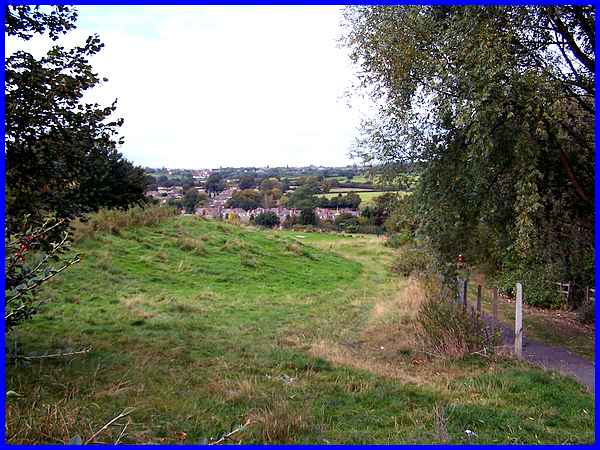
The Blue Line Trail took us from the Lawrence's second home to
their fourth and we left the previous part in this series overlooking
The Canyons on Walker Street. As we backtrack to the third home
we pass the ninth information board on the Trail just a little
further along Walker Street. This one 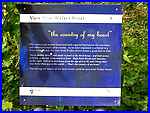 is
titled "View from Walker Street" with a subheading
of "the country of my heart" and recalls how the surrounding
countryside influenced many of his works. The settings for many
of his local stories could be seen from here and an extract from
a letter Bert wrote to a friend from abroad which is reproduced
on the board says "Go to Walker Street - and stand in
front of the third house - and look across at Crich on the left,
Underwood in front - High Park Woods and Annesley on the right.
I lived in that house from the age of 6 to 18, and I know that
view better than any in the world ... that's the country of my
heart." is
titled "View from Walker Street" with a subheading
of "the country of my heart" and recalls how the surrounding
countryside influenced many of his works. The settings for many
of his local stories could be seen from here and an extract from
a letter Bert wrote to a friend from abroad which is reproduced
on the board says "Go to Walker Street - and stand in
front of the third house - and look across at Crich on the left,
Underwood in front - High Park Woods and Annesley on the right.
I lived in that house from the age of 6 to 18, and I know that
view better than any in the world ... that's the country of my
heart."
|
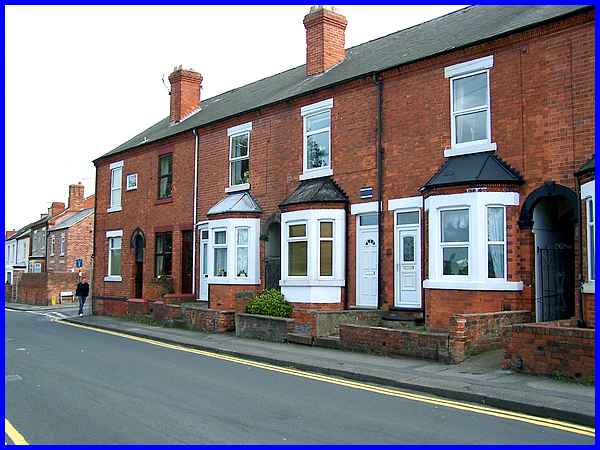
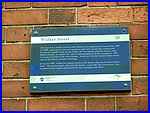 The
house that Bert referred to in his letter is in a block of six
but it is unknown from which end to begin counting. The large
blue information boards seen previously is reduced to a much
smaller plaque here and can be seen above the door of one of
the houses in the middle. The houses were brand new in 1891 when
the family moved from The Breach (Part 07) staying until 1905
before moving on to Lynncroft (also Part 07). The plaque adds
"It was yet another step up the ladder for the family
and the houses were known as 'piano row' due to the prosperity
of the occupants." It was whilst here that Bert's brother
Ernest died in 1901. The
house that Bert referred to in his letter is in a block of six
but it is unknown from which end to begin counting. The large
blue information boards seen previously is reduced to a much
smaller plaque here and can be seen above the door of one of
the houses in the middle. The houses were brand new in 1891 when
the family moved from The Breach (Part 07) staying until 1905
before moving on to Lynncroft (also Part 07). The plaque adds
"It was yet another step up the ladder for the family
and the houses were known as 'piano row' due to the prosperity
of the occupants." It was whilst here that Bert's brother
Ernest died in 1901.
|
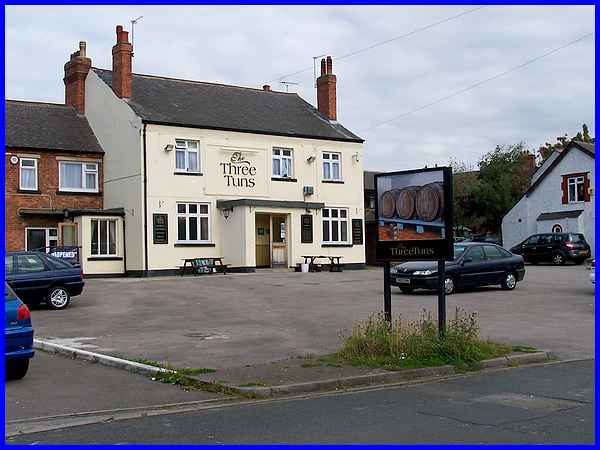
Just around the corner from the Walker Street house is the Three
Tuns pub and a short stub off the Blue Line Trail leads to the
black board by the door of the pub. This is a walk that Bert's
 father
Arthur often made but the heavy drinker would not have stopped
at the door. He often called in for a drink at the Three Tuns,
his favourite pub, on his way home from work at Brinsley Colliery.
His drinking was the cause of many family tensions as his wife
Lydia and the children were members of the Temperance Society.
Lawrence called on memories from this period for characters in
his novels and based the Moon and Stars in "Sons and Lovers"
on the Three Tuns. Further details on the black board show that
the large forecourt in front of the pub is unchanged from Bert's
time and it was here that the "hill top wakes" or fair
was held for three days each September. The area to the east
of Eastwood before the road drops down into Giltbrook is called
Hill Top. father
Arthur often made but the heavy drinker would not have stopped
at the door. He often called in for a drink at the Three Tuns,
his favourite pub, on his way home from work at Brinsley Colliery.
His drinking was the cause of many family tensions as his wife
Lydia and the children were members of the Temperance Society.
Lawrence called on memories from this period for characters in
his novels and based the Moon and Stars in "Sons and Lovers"
on the Three Tuns. Further details on the black board show that
the large forecourt in front of the pub is unchanged from Bert's
time and it was here that the "hill top wakes" or fair
was held for three days each September. The area to the east
of Eastwood before the road drops down into Giltbrook is called
Hill Top.
|
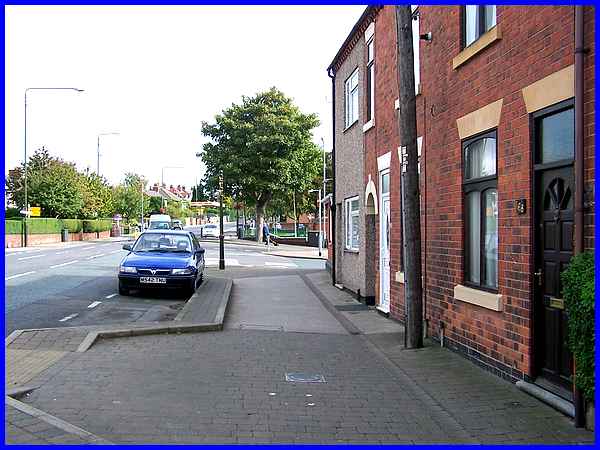
Returning to the main route of the Trail, the painted blue line
now leads to the end of Walker Street where it turns away from
Hill Top and back towards the centre of Eastwood along Nottingham
Road again. At a crossing point we can again pick up the Literary
Trail where the thirteenth plaque sunken into the pavement contains
a quotation from Lady Chatterley's Lover and reads "The
church was away on the left, among black trees. The car slid
on downhill, past the Miners Arms. It had already passed the
Wellington, the Nelson, the Three Tuns and the Sun... and so,
past a few new "villas", out into the blackened road
between dark hedges and dark-green fields, towards Stack Gate."
This view is looking along Nottingham Road towards Hill Top in
the same direction as the car in the quotation was travelling.
|
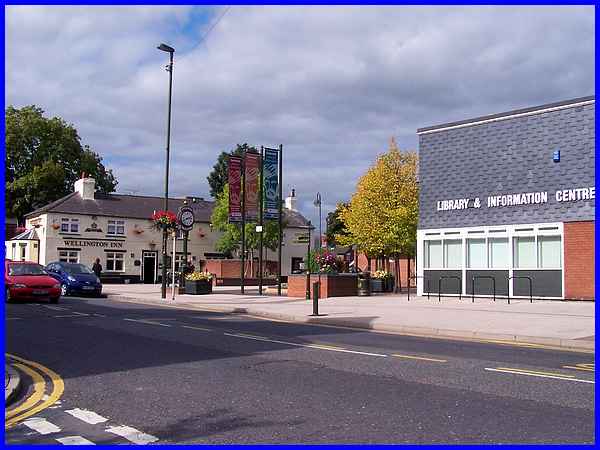
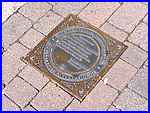 The fourteenth
plaque (left) on the Literary Trail is on the opposite side of
the road outside the library and here we can also see the Wellington
referred to in the previous quotation. Outside the library the
quotation comes from Nottingham and The fourteenth
plaque (left) on the Literary Trail is on the opposite side of
the road outside the library and here we can also see the Wellington
referred to in the previous quotation. Outside the library the
quotation comes from Nottingham and 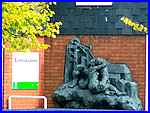 the
Mining Country. It reads "To me it seemed, and still
seems, an extremely beautiful countryside, just between the red
sandstone and the oak-trees of Nottingham and the cold limestone,
the ash-trees, the stone fences of Derbyshire." Inside
the library is an extensive collection of Bert's works including
many personal letters and first editions whilst outside a sculpture
(right) depicts the mining area that influenced his writings. the
Mining Country. It reads "To me it seemed, and still
seems, an extremely beautiful countryside, just between the red
sandstone and the oak-trees of Nottingham and the cold limestone,
the ash-trees, the stone fences of Derbyshire." Inside
the library is an extensive collection of Bert's works including
many personal letters and first editions whilst outside a sculpture
(right) depicts the mining area that influenced his writings.
|
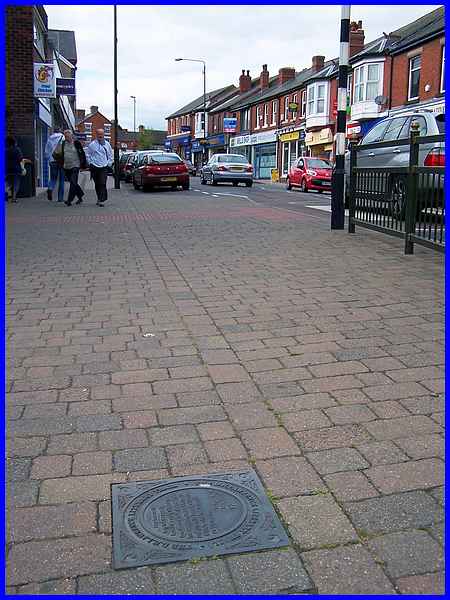
Diagonally across from the library at the junction with Queen's
Road is the final plaque on the Literary Trail but as we continue
to backtrack and approach the town centre from the opposite direction
this is in fact numbered twelve. (The Literary Trail for people
not following the Blue Line actually takes in plaques 12 and
13 before concluding with number 14 at the library). This
twelfth plaque has another quotation from Nottingham and the
Mining Country saying "I was born nearly forty-four years
ago, in Eastwood, a mining village of some three  thousand souls, about eight miles from
Nottingham, and one mile from the small stream, the Erewash,
which divides Nottinghamshire from Derbyshire. It is hilly country
..." thousand souls, about eight miles from
Nottingham, and one mile from the small stream, the Erewash,
which divides Nottinghamshire from Derbyshire. It is hilly country
..."
At this point we are in sight of Nottingham Road's junction
with Wood Street which is where the Blue Line Trail splits to
take in The Breach, Lynncroft and Walker Street so a few more
steps will mean we have completed the circuit. Avid devotees
of the author though can make a short detour from here down Queen's
Road and into Queen's Square to view Bromley House (right) which
was the home of Bert's elder sister Emily.
Although we are now at the end of our exploration of the Blue
Line and Literary Trails it is not the end of the story. D. H.
Lawrence himself in fact would be proud of a cliffhanger such
as this. The spur for starting this series earlier this year
in February 2009 was the news of the possible closure of the
Durban House Heritage Centre. Even as I write this nearly eight
months later the future of the Centre is still in the balance
according to this report in a local newspaper. Eastwood is
currently in the middle of the D. H. Lawrence Festival with numerous
events taking place and the Heritage Centre is at the heart of
the events. Back in February I sought permission to take some
photos inside Durban House but in my haste to upload the first
part that permission was not obtained until after the deadline.
Soon afterwards though the Cultural Services Manager for Broxtowe
Borough Council, Sally Nightingale, not only agreed to my request
but also provided me with a number of the Council's own images.
So rather than repeat the process and with grateful thanks to
Sally and the Council I have now added these images to this bonus
page of Supplementary
Images to bring this series to a fitting conclusion.
For more information about D. H. Lawrence I am also grateful
to the following websites (in no particular order) that have
proved very useful in the preparation of these pages:
Broxtowe Borough Council D. H. Lawrence section
Alan Rowley's Into The Breach
Gavin
Gillespie's Eastwood Site
and the University of Nottingham
|

